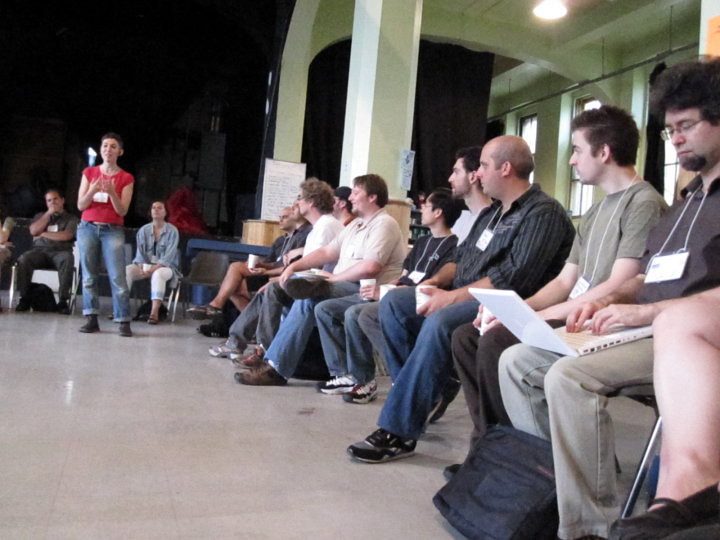The Delphi technique and Nominal Group Technique are both effective tools for decision-making in businesses. Both methods involve gathering information from a group of experts or stakeholders, but the two techniques differ in their approach. The Delphi technique relies on an anonymous feedback system that encourages reflection and self-moderation while the Nominal Group Technique involves more direct interaction between participants which allows for more detailed discussion and debate.
What is the Delphi Technique?
(Photo By goldjiann on Flickr)

The Delphi Technique is a tool used by groups to arrive at a consensus opinion on a issue. It is commonly used when there is no clear consensus on an issue, and can be used to generate ideas or solutions. The technique gets its name from the ancient Greek Oracle at Delphi, who was said to be able to prophesy the future.
The Delphi Technique is usually facilitated by a neutral third party, who poses questions to the group anonymously. This allows for people to share their opinions without fear of judgement or reprisal. The facilitator then collates the responses and shares them with the group, who then discuss and reach a consensus.
The Delphi Technique can be an effective way of reaching agreement in a group, as it allows for all voices to be heard and for everyone to have a say in the final decision. However, it can also be time-consuming, and may not always produce the best results if people are not willing to compromise or change their views.
What is Nominal Group Technique?
(Photo by FORTYTWO on Unsplash )

Nominal Group Technique (NGT) is a structured process for brainstorming and generating ideas from a group of people. It is a useful tool for groups who want to generate a large number of ideas on a topic or issue.
NGT can be used to generate ideas on any topic, but it is particularly useful for complex or controversial topics where there may be many different points of view. NGT helps to ensure that all voices are heard and that all ideas are given equal weight. The process is also helpful for groups who have difficulty reaching consensus, as it allows all members to contribute without pressure to conform to the majority opinion.
The basic steps of NGT are as follows:
- The facilitator explains the task or issue to be addressed and gives each participant a stack of index cards.
- Each participant writes down one idea per card, without discussion or feedback from the other participants.
- Once all participants have finished writing their ideas, each idea is read aloud and recorded by the facilitator. All duplicate ideas are consolidated into one card.
- The facilitator then asks the group to rank the ideas in order of importance, using a voting system such as dot-voting or round-robin voting.
- The final ranking of ideas is used to guide further discussion and decision-making by the group.
Key Differences Between Delphi and Nominal Group Technique
Delphi technique is a systematic, interactive forecasting method which relies on a panel of experts. Nominal group technique is a structured process for brainstorming which involves writing down ideas, sharing them with the group, and then voting on the ideas.
The Delphi technique is anonymous, meaning that experts do not know who else is on the panel. This anonymity encourages honest and unbiased opinions. In contrast, nominal group technique involves face-to-face interaction among participants, which can lead to social pressure and conformity bias.
Another key difference has to do with how ideas are generated. In Delphi technique, experts generate ideas individually before coming together as a group. This allows each expert to put forth their best ideas without being influenced by others in the group. With nominal group technique, on the other hand, all ideas are generated simultaneously as a group. This can lead to “groupthink” where participants censor themselves and don’t voice controversial opinions for fear of upsetting others in the group.
Finally, Delphi technique relies heavily on statistical analysis and mathematical modeling, while nominal group technique does not. This makes Delphi technique more suited for quantitative forecasting problems, while nominal group technique is better suited for qualitative problems.
What is an example of Delphi technique?
The Delphi technique is a structured, interactive method used to gain the opinions of a group of experts. This technique is often used when there is no clear consensus on an issue and can be used to generate ideas or to reach a consensus on a course of action.
To use the Delphi technique, a facilitator poses a question or problem to a group of experts. Each expert responds anonymously, without discussion or debate. The facilitator then collects and collates the responses and presents them back to the group. This process is repeated until there is consensus on the issue among the experts.
What is an example of Nominal Group Technique?
Nominal group technique (NGT) is a tool used by groups to generate ideas and reach consensus. It was developed by J. L. Morehouse in the 1950s as an alternative to brainstorming. NGT is a structured process that allows for equal participation from all members of the group, and it can be used to generate a large number of ideas in a short amount of time.
Here’s an example of how NGT works:
- The facilitator explains the purpose of the meeting and asks each participant to write down three ideas related to the topic at hand.
- Each participant shares their ideas with the group, and the facilitator records them on a whiteboard or flipchart.
- The group then votes on the ideas, and the ones with the most votes are discussed further.
- The group reaches consensus on the final set of ideas, and these are recorded for future reference.
Where is Nominal Group Technique used?
Nominal group technique is a tool that is used to generate ideas and reach consensus. It is typically used in situations where there is no clear leader and participants need to come to an agreement. The nominal group technique can be used in businesses, schools, and other organizations.
Where is Nominal Delphi technique used?
Nominal Delphi technique is used when a panel of experts are asked to anonymously provide their opinions on a topic, and the responses are compiled and shared with the group. This allows the experts to build on each other’s ideas and come to a consensus without being influenced by any one individual. The technique is often used when there is no clear consensus on an issue, or when it is difficult to bring all of the experts together in one place.
What are the advantages and disadvantages of Nominal Group Technique?
Nominal Group Technique (NGT) is a structured method for generating and prioritizing ideas or solutions in a group setting. It involves the following steps:
- Participants generate ideas independently and silently.
- Ideas are shared and recorded one at a time.
- Participants discuss and clarify the ideas.
- Participants rank or vote on the ideas to prioritize them.
Advantages of Nominal Group Technique:
- Equal participation: NGT ensures that each participant has an equal opportunity to contribute and that no one dominates the conversation.
- Structured approach: NGT provides a structured approach to idea generation, which can help to reduce confusion and ensure that all ideas are considered.
- Prioritization of ideas: NGT allows for the prioritization of ideas, which can help to focus attention on the most important or promising solutions.
- Increased creativity: The individual brainstorming step of NGT encourages participants to think creatively and independently, which can lead to more innovative ideas.
Disadvantages of Nominal Group Technique:
- Time-consuming: NGT can be time-consuming, particularly if there are a large number of participants or ideas to consider.
- Limited discussion: Because ideas are presented one at a time, there may be limited opportunity for discussion or debate.
- Limited input: Some participants may be less comfortable sharing their ideas in a group setting, which can limit the diversity of input.
- Limited scope: NGT is best suited to generating and prioritizing ideas or solutions, but may not be as effective for more complex decision-making processes.
NGT can be a useful tool for generating and prioritizing ideas or solutions in a group setting. Its advantages include equal participation, a structured approach, prioritization of ideas, and increased creativity. Its disadvantages include being time-consuming, limited discussion, limited input, and limited scope.
What are the advantages and disadvantages of Delphi technique?
There are a few key advantages and disadvantages of the Delphi technique that are worth considering:
Advantages:
- The Delphi technique can be used to generate ideas and reach consensus among a group of experts without the need for face-to-face interaction, which can save time and money.
- This method can be used to anonymously gather opinions from a group of people, which can encourage honest and unbiased feedback.
- The Delphi technique can help to reduce the risk of bias by allowing experts to revise and improve their responses after seeing the opinions of other experts.
- This method can produce more reliable results than less structured methods, such as brainstorming, due to the iterative nature of the Delphi technique.
- The Delphi technique can be used to solicit feedback from a large number of people without overburdening any single individual.
Disadvantages:
- The results of the Delphi technique may be influenced by the personal biases of the experts involved in the study.
- The process may take longer than some other methods, such as brainstorming, due to its iterative nature.
- Some experts may feel reluctant to participate in the study if they believe their anonymity will not be protected.
Featured Image By – Photo by Jason Goodman on Unsplash









